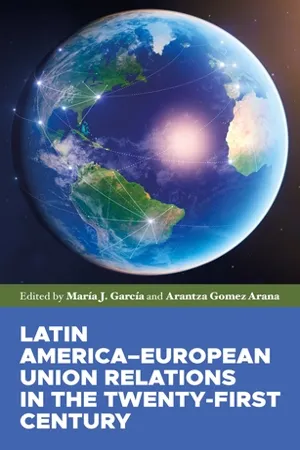
Latin America–European Union relations in the twenty-first century
- 216 pages
- English
- ePUB (mobile friendly)
- Available on iOS & Android
Latin America–European Union relations in the twenty-first century
About this book
Latin America–European Union relations in the twenty-first century provides a valuable overview of transatlantic trade agreement negotiations and developments in the first decades of the twenty-first century. This edited collection examines key motivations behind trade agreements, traces the evolution of negotiations and explores some of the initial impacts of new generation trade agreements with the EU on South American countries. The book makes an important contribution to our understanding of relations between these regions by contextualising relations and trade agendas, both in terms of domestic political and economic policies and broader global trends. It demonstrates the importance of a shift toward mega-regional trade agreements in the 2010s, particularly under the Obama administration in the United States, in shaping South American and European agendas for trade agreement negotiations and their outcomes.Detailed case studies in the book investigate EU relations and negotiations with countries that have successfully negotiated new generation trade agreements with the EU: Mercosur, the Andean states, Chile and Mexico. Other contributions offer a wider overview of EU-Latin American relations, including parliamentary and civil society relations. The net result is a balanced analysis of contemporary EU relations with South America, useful for students and scholars of foreign policy and political economy in both regions.
Frequently asked questions
- Essential is ideal for learners and professionals who enjoy exploring a wide range of subjects. Access the Essential Library with 800,000+ trusted titles and best-sellers across business, personal growth, and the humanities. Includes unlimited reading time and Standard Read Aloud voice.
- Complete: Perfect for advanced learners and researchers needing full, unrestricted access. Unlock 1.4M+ books across hundreds of subjects, including academic and specialized titles. The Complete Plan also includes advanced features like Premium Read Aloud and Research Assistant.
Please note we cannot support devices running on iOS 13 and Android 7 or earlier. Learn more about using the app.
Information
1
Latin American and European Union relations in an interdependent world going through “deglobalisation”
Introduction
The BRICs
Table of contents
- Cover
- Half-title page
- Title page
- Copyright page
- Contents
- List of tables and figures
- Notes on contributors
- List of abbreviations
- Introduction
- 1: Latin American and European Union relations in an interdependent world going through “deglobalisation”
- 2: EU–LAC: a relationship beyond trade: political dialogues between unequal partners
- 3: Interlinkages in EU–Andean Community trade negotiations
- 4: The EU–Peru/Colombia trade agreement: balancing, accommodation or driver of change?
- 5: EU–Mexican relations: adaptation to global trade relations
- 6: Twenty years of EU–MERCOSUR negotiations: inter-regionalism and the crisis of globalisation
- 7: Inter-regionalism beyond the executives: contemporary dynamics of EU–LAC inter-parliamentary relations
- 8: The impact of European political dialogue upon Chilean and Mexican domestic policies
- Conclusion: The more things change the more they stay the same?
- Index